Stakeholder Impact on Air New Zealand's Business Transformation Plan
VerifiedAdded on 2023/06/11
|16
|5194
|161
Report
AI Summary
This report analyzes Air New Zealand's transformation objectives and compliance requirements. It identifies key internal (senior managers) and external (New Zealand government) stakeholders and justifies their importance in transformation planning. The report recommends improving innovative and financial performance, and achieving strategic and operational objectives. It emphasizes ethical decision-making and stakeholder identification. The analysis covers Air New Zealand's digital transformation, financial results, and sustainable development initiatives. The report also addresses internal and external compliance requirements, including safety regulations and environmental standards, and outlines a communication plan for effective change management, highlighting the need for transparency and stakeholder engagement. This document is available on Desklib, a platform offering a wide range of study tools and solved assignments for students.
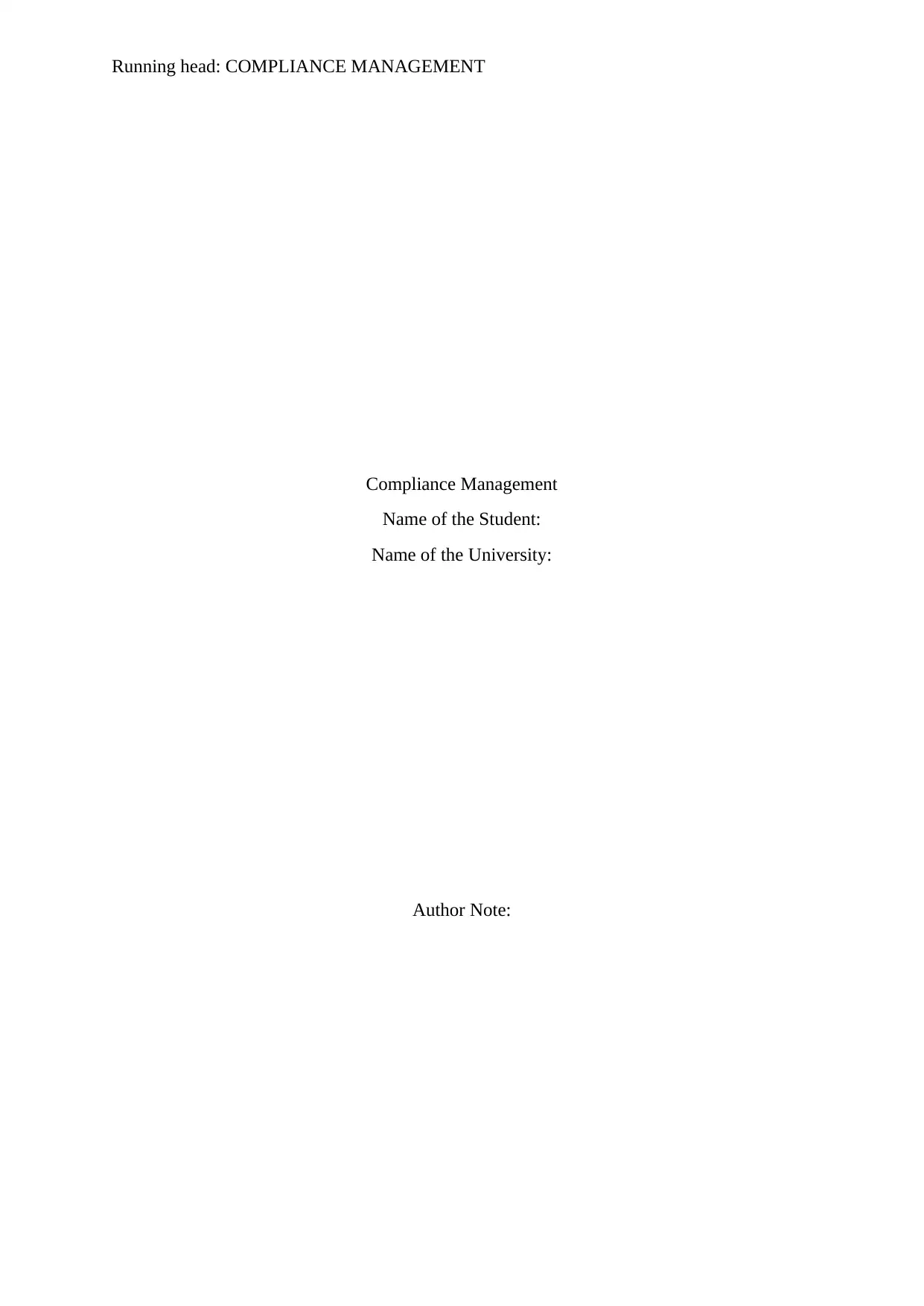
Running head: COMPLIANCE MANAGEMENT
Compliance Management
Name of the Student:
Name of the University:
Author Note:
Compliance Management
Name of the Student:
Name of the University:
Author Note:
Paraphrase This Document
Need a fresh take? Get an instant paraphrase of this document with our AI Paraphraser
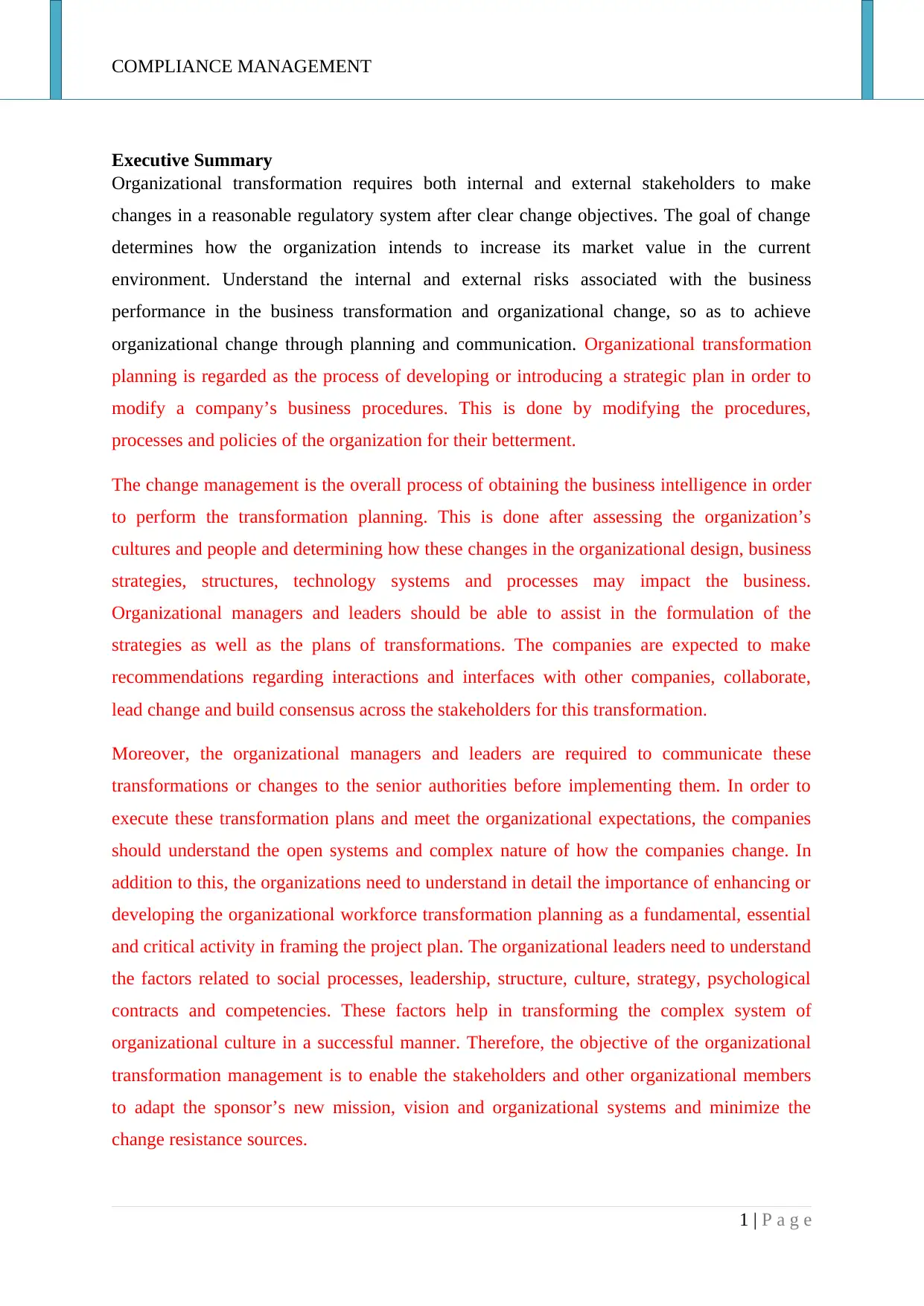
COMPLIANCE MANAGEMENT
Executive Summary
Organizational transformation requires both internal and external stakeholders to make
changes in a reasonable regulatory system after clear change objectives. The goal of change
determines how the organization intends to increase its market value in the current
environment. Understand the internal and external risks associated with the business
performance in the business transformation and organizational change, so as to achieve
organizational change through planning and communication. Organizational transformation
planning is regarded as the process of developing or introducing a strategic plan in order to
modify a company’s business procedures. This is done by modifying the procedures,
processes and policies of the organization for their betterment.
The change management is the overall process of obtaining the business intelligence in order
to perform the transformation planning. This is done after assessing the organization’s
cultures and people and determining how these changes in the organizational design, business
strategies, structures, technology systems and processes may impact the business.
Organizational managers and leaders should be able to assist in the formulation of the
strategies as well as the plans of transformations. The companies are expected to make
recommendations regarding interactions and interfaces with other companies, collaborate,
lead change and build consensus across the stakeholders for this transformation.
Moreover, the organizational managers and leaders are required to communicate these
transformations or changes to the senior authorities before implementing them. In order to
execute these transformation plans and meet the organizational expectations, the companies
should understand the open systems and complex nature of how the companies change. In
addition to this, the organizations need to understand in detail the importance of enhancing or
developing the organizational workforce transformation planning as a fundamental, essential
and critical activity in framing the project plan. The organizational leaders need to understand
the factors related to social processes, leadership, structure, culture, strategy, psychological
contracts and competencies. These factors help in transforming the complex system of
organizational culture in a successful manner. Therefore, the objective of the organizational
transformation management is to enable the stakeholders and other organizational members
to adapt the sponsor’s new mission, vision and organizational systems and minimize the
change resistance sources.
1 | P a g e
Executive Summary
Organizational transformation requires both internal and external stakeholders to make
changes in a reasonable regulatory system after clear change objectives. The goal of change
determines how the organization intends to increase its market value in the current
environment. Understand the internal and external risks associated with the business
performance in the business transformation and organizational change, so as to achieve
organizational change through planning and communication. Organizational transformation
planning is regarded as the process of developing or introducing a strategic plan in order to
modify a company’s business procedures. This is done by modifying the procedures,
processes and policies of the organization for their betterment.
The change management is the overall process of obtaining the business intelligence in order
to perform the transformation planning. This is done after assessing the organization’s
cultures and people and determining how these changes in the organizational design, business
strategies, structures, technology systems and processes may impact the business.
Organizational managers and leaders should be able to assist in the formulation of the
strategies as well as the plans of transformations. The companies are expected to make
recommendations regarding interactions and interfaces with other companies, collaborate,
lead change and build consensus across the stakeholders for this transformation.
Moreover, the organizational managers and leaders are required to communicate these
transformations or changes to the senior authorities before implementing them. In order to
execute these transformation plans and meet the organizational expectations, the companies
should understand the open systems and complex nature of how the companies change. In
addition to this, the organizations need to understand in detail the importance of enhancing or
developing the organizational workforce transformation planning as a fundamental, essential
and critical activity in framing the project plan. The organizational leaders need to understand
the factors related to social processes, leadership, structure, culture, strategy, psychological
contracts and competencies. These factors help in transforming the complex system of
organizational culture in a successful manner. Therefore, the objective of the organizational
transformation management is to enable the stakeholders and other organizational members
to adapt the sponsor’s new mission, vision and organizational systems and minimize the
change resistance sources.
1 | P a g e

COMPLIANCE MANAGEMENT
Introduction
I analyzed the transformation objectives and compliance requirements of New Zealand
aviation. Air New Zealand's operations include services for passengers and cargo, aircraft
maintenance and ground service. According to the company's sustainable development, the
company needs to organize and change constantly. The New Zealand government established
the national airline in 1947 and then merged with the airline. The history of Air New Zealand
began when the Cook Strait Airways amalgamated with the East Coast Airways. The national
carrier of the New Zealand began their operations in the year 1936 as the first major airline of
the country (Airnewzealand.in. (2018).
The Union Airways was considered to be the sole aviation partner of New Zealand in Tasman
Empire Airways Limited, often abbreviated as TEAL. They made their inaugural flight in the
year 1940. In the year 1961, the New Zealand Government bought total ownership of TEAL
and moreover, the airline was then renamed to Air New Zealand in the year 1965. In addition
to this, the domestic airline of New Zealand, National Airways Corporation was combined
with the Air New Zealand in the year 1978. However, Air New Zealand was being privatized
in the year 1989 and in the early 2000s, the company got into financial trouble. Moreover, in
the year 2001, the government officials of New Zealand took up to 80% of the ownership.
The company then decided to bring about some changes or transformation within their
organizational objectives or compliance requirements.
The airline was first being established as TEAL and their first flight was on April 30, 1940.
The report will throw light over the transformation and innovation of the company. The
impact of the transformation and innovation of the company is the main scope of this
assignment analysis. The company is now trying to be the best digital airline all across the
world. The report discusses in detail about the performance as well as organizational
objectives and the interests of the stakeholders in the transformation of the business. In
addition to this, it also throws light over the internal and the external stakeholders of the
business who should be actively involved into the planning of the transformation procedures.
Task 1: Performance and organizational objectives and stakeholder interests in
business transformation
(a) Identification of one internal and external stakeholder for the transformation processes
• Internal: Senior manager
2 | P a g e
Introduction
I analyzed the transformation objectives and compliance requirements of New Zealand
aviation. Air New Zealand's operations include services for passengers and cargo, aircraft
maintenance and ground service. According to the company's sustainable development, the
company needs to organize and change constantly. The New Zealand government established
the national airline in 1947 and then merged with the airline. The history of Air New Zealand
began when the Cook Strait Airways amalgamated with the East Coast Airways. The national
carrier of the New Zealand began their operations in the year 1936 as the first major airline of
the country (Airnewzealand.in. (2018).
The Union Airways was considered to be the sole aviation partner of New Zealand in Tasman
Empire Airways Limited, often abbreviated as TEAL. They made their inaugural flight in the
year 1940. In the year 1961, the New Zealand Government bought total ownership of TEAL
and moreover, the airline was then renamed to Air New Zealand in the year 1965. In addition
to this, the domestic airline of New Zealand, National Airways Corporation was combined
with the Air New Zealand in the year 1978. However, Air New Zealand was being privatized
in the year 1989 and in the early 2000s, the company got into financial trouble. Moreover, in
the year 2001, the government officials of New Zealand took up to 80% of the ownership.
The company then decided to bring about some changes or transformation within their
organizational objectives or compliance requirements.
The airline was first being established as TEAL and their first flight was on April 30, 1940.
The report will throw light over the transformation and innovation of the company. The
impact of the transformation and innovation of the company is the main scope of this
assignment analysis. The company is now trying to be the best digital airline all across the
world. The report discusses in detail about the performance as well as organizational
objectives and the interests of the stakeholders in the transformation of the business. In
addition to this, it also throws light over the internal and the external stakeholders of the
business who should be actively involved into the planning of the transformation procedures.
Task 1: Performance and organizational objectives and stakeholder interests in
business transformation
(a) Identification of one internal and external stakeholder for the transformation processes
• Internal: Senior manager
2 | P a g e
⊘ This is a preview!⊘
Do you want full access?
Subscribe today to unlock all pages.

Trusted by 1+ million students worldwide

COMPLIANCE MANAGEMENT
The active and visible participation of senior leaders is considered to be the first
contributor to change management success. The motivation and rationale for reform
management is to provide support for business teams and senior leaders. (BEST
PRACTICES IN, 2016)
• External: New Zealand government
The New Zealand Government currently owns 52% of Air New Zealand ordinary
shares. (Frequently Asked Questions, 2018)Government's role is mainly as policymakers and
regulators, the government will continue to maintain positive agreement with air New Zealand, in
order to provide more opportunities to enter international markets and trade in the future. (Ministry
of Transport, 2018)
(b)
Internal: Transformation requires close cooperation among internal stakeholders in setting
goals and completing goals. For example, high-level management is always required in the
process of business transformation. Senior managers and transformation teams develop
transformation plans through decision-making discussions, then communicate the tasks to
internal staff and start implementing innovative ideas. Second, internal human resources
allocation is also very important in business transformation. The vast majority of employees
are faced with challenges in terms of technology, ideas, and thinking. Only if there is a
fundamental change in the way employees operate, think, and behave will the transformation
be completed. The company should reasonably solve the conflict between the transition
demand and the daily management demand, and the internal resources allocation to the best
state. As a top-down implementation process, the importance of active involvement of all
internal stakeholders is evident.
External: The transformation of the company and external stakeholders are very important in
establishing common interests. For example, if the external stakeholders lose faith in the
vision of an organization, they will support their support, and this can trigger a decline or a
crisis (ORGANIZATIONAL TRANSFORMATION). The support of external stakeholders
has brought great competitive advantage to the company. Companies need to communicate
constantly with the external stakeholders that are the customers, supply and the, partners,
government, community and more, through their feedback during the strategic reform to
adjust organizational transformation. The participation of external stakeholders is the
guarantee of business transformation, so that the company can evaluate the external crisis,
3 | P a g e
The active and visible participation of senior leaders is considered to be the first
contributor to change management success. The motivation and rationale for reform
management is to provide support for business teams and senior leaders. (BEST
PRACTICES IN, 2016)
• External: New Zealand government
The New Zealand Government currently owns 52% of Air New Zealand ordinary
shares. (Frequently Asked Questions, 2018)Government's role is mainly as policymakers and
regulators, the government will continue to maintain positive agreement with air New Zealand, in
order to provide more opportunities to enter international markets and trade in the future. (Ministry
of Transport, 2018)
(b)
Internal: Transformation requires close cooperation among internal stakeholders in setting
goals and completing goals. For example, high-level management is always required in the
process of business transformation. Senior managers and transformation teams develop
transformation plans through decision-making discussions, then communicate the tasks to
internal staff and start implementing innovative ideas. Second, internal human resources
allocation is also very important in business transformation. The vast majority of employees
are faced with challenges in terms of technology, ideas, and thinking. Only if there is a
fundamental change in the way employees operate, think, and behave will the transformation
be completed. The company should reasonably solve the conflict between the transition
demand and the daily management demand, and the internal resources allocation to the best
state. As a top-down implementation process, the importance of active involvement of all
internal stakeholders is evident.
External: The transformation of the company and external stakeholders are very important in
establishing common interests. For example, if the external stakeholders lose faith in the
vision of an organization, they will support their support, and this can trigger a decline or a
crisis (ORGANIZATIONAL TRANSFORMATION). The support of external stakeholders
has brought great competitive advantage to the company. Companies need to communicate
constantly with the external stakeholders that are the customers, supply and the, partners,
government, community and more, through their feedback during the strategic reform to
adjust organizational transformation. The participation of external stakeholders is the
guarantee of business transformation, so that the company can evaluate the external crisis,
3 | P a g e
Paraphrase This Document
Need a fresh take? Get an instant paraphrase of this document with our AI Paraphraser

COMPLIANCE MANAGEMENT
and can conduct normal business operation in a relatively stable environment. So it is
important for external stakeholders to participate in the transformation.
(c)
Performance:
1. Air New Zealand achieves its business transformation by improving innovative
performance. Air New Zealand has been moving towards its goal of becoming one of the
world's best digital airlines in 2015. (Digital, 2018)The company continues to launch
innovative strategies to accelerate the transformation of air New Zealand.
• Innovative performance provides clear objectives for change initiatives and measures the
progress of the company's business transformation based on market feedback. Businesses
need to constantly reinvent themselves to remain viable and to inspire business
transformation. Air New Zealand's Air band, a revolutionary wristband designed for
unaccompanied children, was named the annual innovation award at the 2016 CAPA
asia-pacific aviation awards. (Air New Zealand Airband™ Innovation of the Year, 2018)
It has realized the Air New Zealand in the field of digital innovation, reveals the
company strategic leadership in the industry, improve the company on the social
influence and reputation to ensure and promote the business transformation.
2. Business transformation involves in the making of fundamental changes in the businesses
conducted for helping the organizational managers in coping up with the market
environmental shifts. Air New Zealand has changed their strategies in order to engage
digitally with the customers all across multiple international markets. It has obvious
performance in financial performance. Moreover, it has helped in enhancing the new
revenue scope or opportunities which the digital world brings in, while driving the
customer innovation. The company’s senior leaders have helped in bringing in the most
innovative companies all across the industry, which include Barnes & Noble, Google,
Intuit and Olive Software. According to New Zealand's interim financial report for 2018,
the company's interim results were $323 million, the second-highest profit margin in the
company's history. (Media Release, 2018)This is the result of the company's focus on
sustainable costs, which is driven by a 5.6 per cent increase in revenues and particularly
strong growth in short - distance networks.
• Business transformation requires strong economic strength. On the one hand, financial
performance can monitor and measure the system and integrity of performance.
4 | P a g e
and can conduct normal business operation in a relatively stable environment. So it is
important for external stakeholders to participate in the transformation.
(c)
Performance:
1. Air New Zealand achieves its business transformation by improving innovative
performance. Air New Zealand has been moving towards its goal of becoming one of the
world's best digital airlines in 2015. (Digital, 2018)The company continues to launch
innovative strategies to accelerate the transformation of air New Zealand.
• Innovative performance provides clear objectives for change initiatives and measures the
progress of the company's business transformation based on market feedback. Businesses
need to constantly reinvent themselves to remain viable and to inspire business
transformation. Air New Zealand's Air band, a revolutionary wristband designed for
unaccompanied children, was named the annual innovation award at the 2016 CAPA
asia-pacific aviation awards. (Air New Zealand Airband™ Innovation of the Year, 2018)
It has realized the Air New Zealand in the field of digital innovation, reveals the
company strategic leadership in the industry, improve the company on the social
influence and reputation to ensure and promote the business transformation.
2. Business transformation involves in the making of fundamental changes in the businesses
conducted for helping the organizational managers in coping up with the market
environmental shifts. Air New Zealand has changed their strategies in order to engage
digitally with the customers all across multiple international markets. It has obvious
performance in financial performance. Moreover, it has helped in enhancing the new
revenue scope or opportunities which the digital world brings in, while driving the
customer innovation. The company’s senior leaders have helped in bringing in the most
innovative companies all across the industry, which include Barnes & Noble, Google,
Intuit and Olive Software. According to New Zealand's interim financial report for 2018,
the company's interim results were $323 million, the second-highest profit margin in the
company's history. (Media Release, 2018)This is the result of the company's focus on
sustainable costs, which is driven by a 5.6 per cent increase in revenues and particularly
strong growth in short - distance networks.
• Business transformation requires strong economic strength. On the one hand, financial
performance can monitor and measure the system and integrity of performance.
4 | P a g e
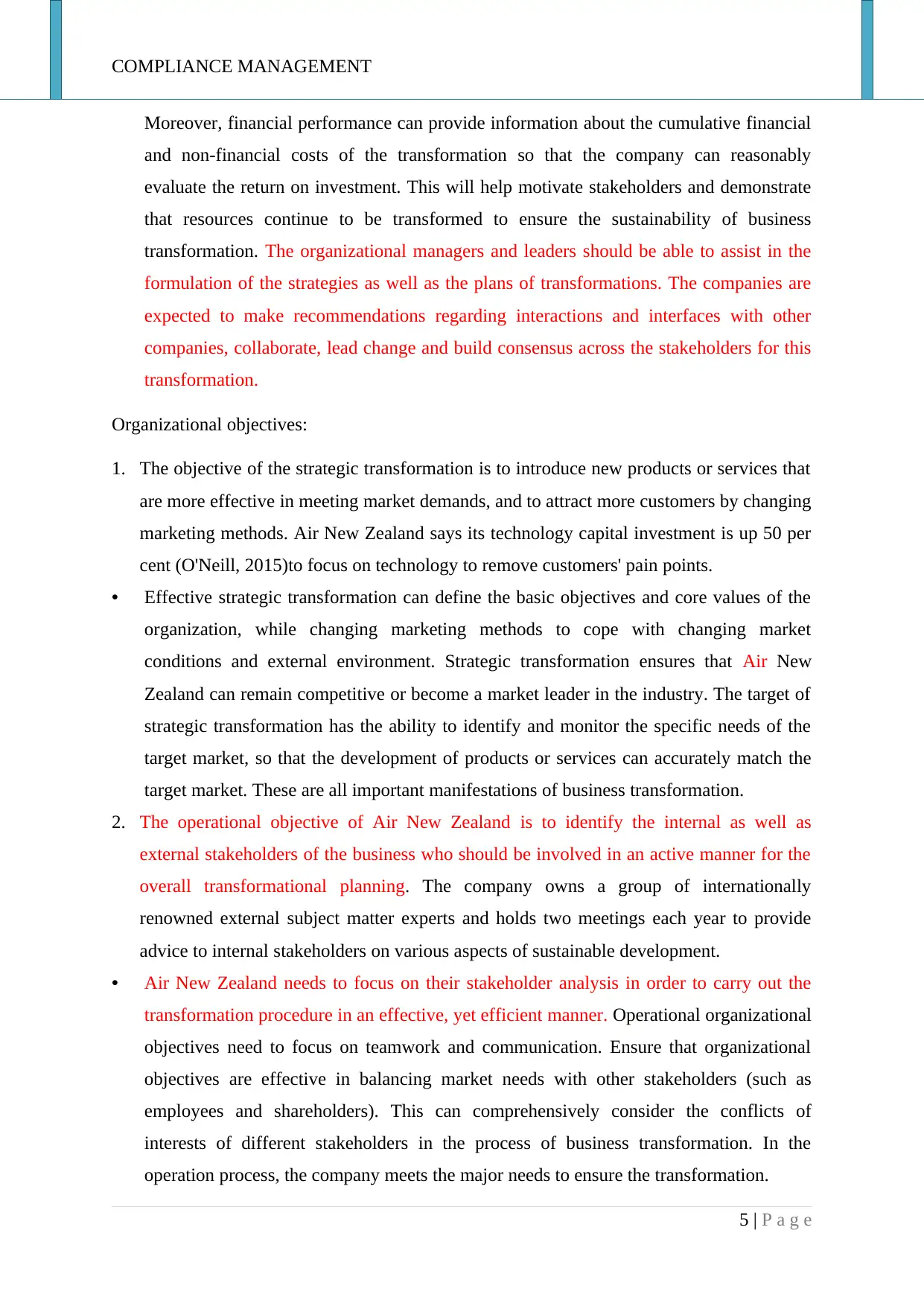
COMPLIANCE MANAGEMENT
Moreover, financial performance can provide information about the cumulative financial
and non-financial costs of the transformation so that the company can reasonably
evaluate the return on investment. This will help motivate stakeholders and demonstrate
that resources continue to be transformed to ensure the sustainability of business
transformation. The organizational managers and leaders should be able to assist in the
formulation of the strategies as well as the plans of transformations. The companies are
expected to make recommendations regarding interactions and interfaces with other
companies, collaborate, lead change and build consensus across the stakeholders for this
transformation.
Organizational objectives:
1. The objective of the strategic transformation is to introduce new products or services that
are more effective in meeting market demands, and to attract more customers by changing
marketing methods. Air New Zealand says its technology capital investment is up 50 per
cent (O'Neill, 2015)to focus on technology to remove customers' pain points.
• Effective strategic transformation can define the basic objectives and core values of the
organization, while changing marketing methods to cope with changing market
conditions and external environment. Strategic transformation ensures that Air New
Zealand can remain competitive or become a market leader in the industry. The target of
strategic transformation has the ability to identify and monitor the specific needs of the
target market, so that the development of products or services can accurately match the
target market. These are all important manifestations of business transformation.
2. The operational objective of Air New Zealand is to identify the internal as well as
external stakeholders of the business who should be involved in an active manner for the
overall transformational planning. The company owns a group of internationally
renowned external subject matter experts and holds two meetings each year to provide
advice to internal stakeholders on various aspects of sustainable development.
• Air New Zealand needs to focus on their stakeholder analysis in order to carry out the
transformation procedure in an effective, yet efficient manner. Operational organizational
objectives need to focus on teamwork and communication. Ensure that organizational
objectives are effective in balancing market needs with other stakeholders (such as
employees and shareholders). This can comprehensively consider the conflicts of
interests of different stakeholders in the process of business transformation. In the
operation process, the company meets the major needs to ensure the transformation.
5 | P a g e
Moreover, financial performance can provide information about the cumulative financial
and non-financial costs of the transformation so that the company can reasonably
evaluate the return on investment. This will help motivate stakeholders and demonstrate
that resources continue to be transformed to ensure the sustainability of business
transformation. The organizational managers and leaders should be able to assist in the
formulation of the strategies as well as the plans of transformations. The companies are
expected to make recommendations regarding interactions and interfaces with other
companies, collaborate, lead change and build consensus across the stakeholders for this
transformation.
Organizational objectives:
1. The objective of the strategic transformation is to introduce new products or services that
are more effective in meeting market demands, and to attract more customers by changing
marketing methods. Air New Zealand says its technology capital investment is up 50 per
cent (O'Neill, 2015)to focus on technology to remove customers' pain points.
• Effective strategic transformation can define the basic objectives and core values of the
organization, while changing marketing methods to cope with changing market
conditions and external environment. Strategic transformation ensures that Air New
Zealand can remain competitive or become a market leader in the industry. The target of
strategic transformation has the ability to identify and monitor the specific needs of the
target market, so that the development of products or services can accurately match the
target market. These are all important manifestations of business transformation.
2. The operational objective of Air New Zealand is to identify the internal as well as
external stakeholders of the business who should be involved in an active manner for the
overall transformational planning. The company owns a group of internationally
renowned external subject matter experts and holds two meetings each year to provide
advice to internal stakeholders on various aspects of sustainable development.
• Air New Zealand needs to focus on their stakeholder analysis in order to carry out the
transformation procedure in an effective, yet efficient manner. Operational organizational
objectives need to focus on teamwork and communication. Ensure that organizational
objectives are effective in balancing market needs with other stakeholders (such as
employees and shareholders). This can comprehensively consider the conflicts of
interests of different stakeholders in the process of business transformation. In the
operation process, the company meets the major needs to ensure the transformation.
5 | P a g e
⊘ This is a preview!⊘
Do you want full access?
Subscribe today to unlock all pages.

Trusted by 1+ million students worldwide
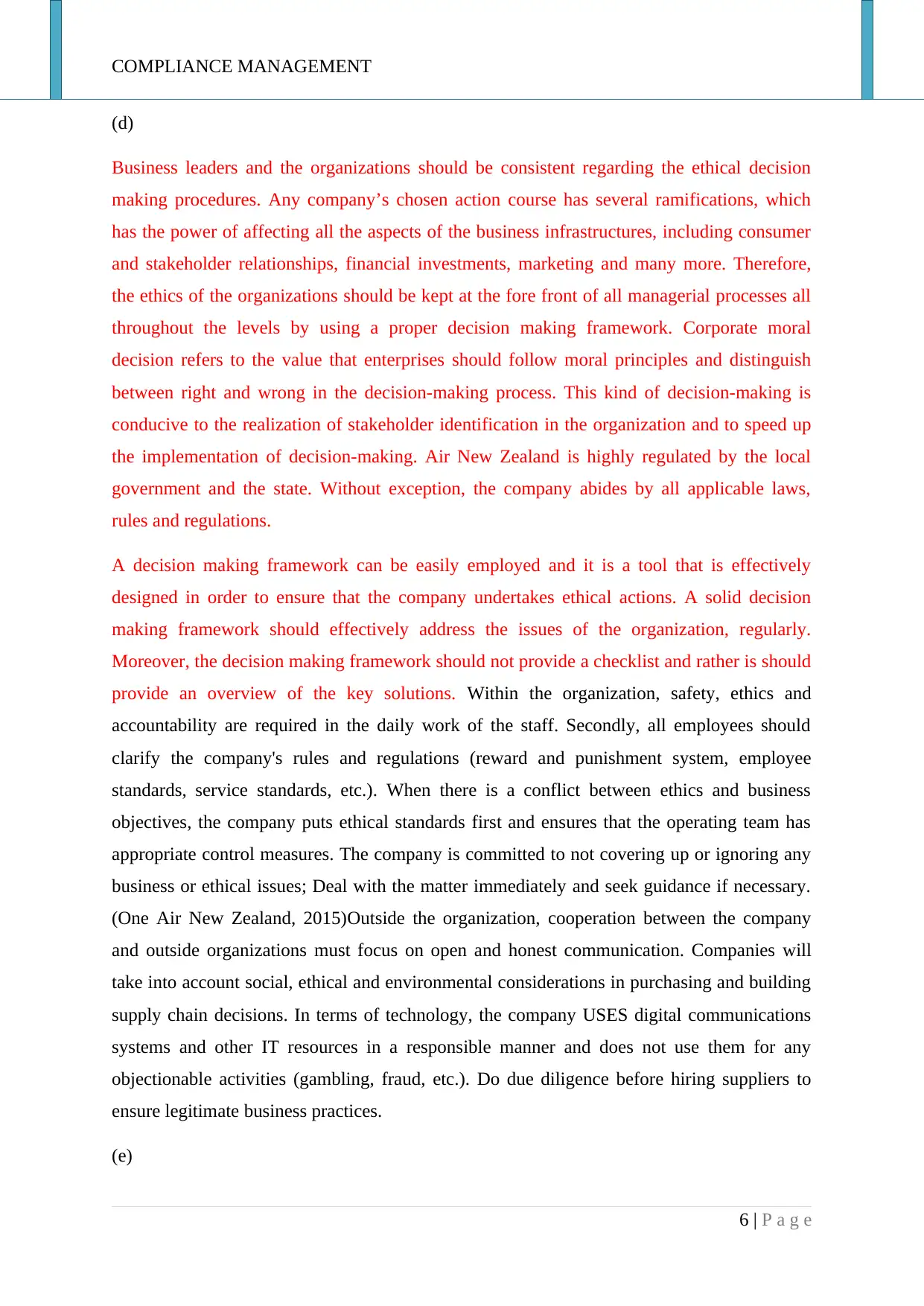
COMPLIANCE MANAGEMENT
(d)
Business leaders and the organizations should be consistent regarding the ethical decision
making procedures. Any company’s chosen action course has several ramifications, which
has the power of affecting all the aspects of the business infrastructures, including consumer
and stakeholder relationships, financial investments, marketing and many more. Therefore,
the ethics of the organizations should be kept at the fore front of all managerial processes all
throughout the levels by using a proper decision making framework. Corporate moral
decision refers to the value that enterprises should follow moral principles and distinguish
between right and wrong in the decision-making process. This kind of decision-making is
conducive to the realization of stakeholder identification in the organization and to speed up
the implementation of decision-making. Air New Zealand is highly regulated by the local
government and the state. Without exception, the company abides by all applicable laws,
rules and regulations.
A decision making framework can be easily employed and it is a tool that is effectively
designed in order to ensure that the company undertakes ethical actions. A solid decision
making framework should effectively address the issues of the organization, regularly.
Moreover, the decision making framework should not provide a checklist and rather is should
provide an overview of the key solutions. Within the organization, safety, ethics and
accountability are required in the daily work of the staff. Secondly, all employees should
clarify the company's rules and regulations (reward and punishment system, employee
standards, service standards, etc.). When there is a conflict between ethics and business
objectives, the company puts ethical standards first and ensures that the operating team has
appropriate control measures. The company is committed to not covering up or ignoring any
business or ethical issues; Deal with the matter immediately and seek guidance if necessary.
(One Air New Zealand, 2015)Outside the organization, cooperation between the company
and outside organizations must focus on open and honest communication. Companies will
take into account social, ethical and environmental considerations in purchasing and building
supply chain decisions. In terms of technology, the company USES digital communications
systems and other IT resources in a responsible manner and does not use them for any
objectionable activities (gambling, fraud, etc.). Do due diligence before hiring suppliers to
ensure legitimate business practices.
(e)
6 | P a g e
(d)
Business leaders and the organizations should be consistent regarding the ethical decision
making procedures. Any company’s chosen action course has several ramifications, which
has the power of affecting all the aspects of the business infrastructures, including consumer
and stakeholder relationships, financial investments, marketing and many more. Therefore,
the ethics of the organizations should be kept at the fore front of all managerial processes all
throughout the levels by using a proper decision making framework. Corporate moral
decision refers to the value that enterprises should follow moral principles and distinguish
between right and wrong in the decision-making process. This kind of decision-making is
conducive to the realization of stakeholder identification in the organization and to speed up
the implementation of decision-making. Air New Zealand is highly regulated by the local
government and the state. Without exception, the company abides by all applicable laws,
rules and regulations.
A decision making framework can be easily employed and it is a tool that is effectively
designed in order to ensure that the company undertakes ethical actions. A solid decision
making framework should effectively address the issues of the organization, regularly.
Moreover, the decision making framework should not provide a checklist and rather is should
provide an overview of the key solutions. Within the organization, safety, ethics and
accountability are required in the daily work of the staff. Secondly, all employees should
clarify the company's rules and regulations (reward and punishment system, employee
standards, service standards, etc.). When there is a conflict between ethics and business
objectives, the company puts ethical standards first and ensures that the operating team has
appropriate control measures. The company is committed to not covering up or ignoring any
business or ethical issues; Deal with the matter immediately and seek guidance if necessary.
(One Air New Zealand, 2015)Outside the organization, cooperation between the company
and outside organizations must focus on open and honest communication. Companies will
take into account social, ethical and environmental considerations in purchasing and building
supply chain decisions. In terms of technology, the company USES digital communications
systems and other IT resources in a responsible manner and does not use them for any
objectionable activities (gambling, fraud, etc.). Do due diligence before hiring suppliers to
ensure legitimate business practices.
(e)
6 | P a g e
Paraphrase This Document
Need a fresh take? Get an instant paraphrase of this document with our AI Paraphraser
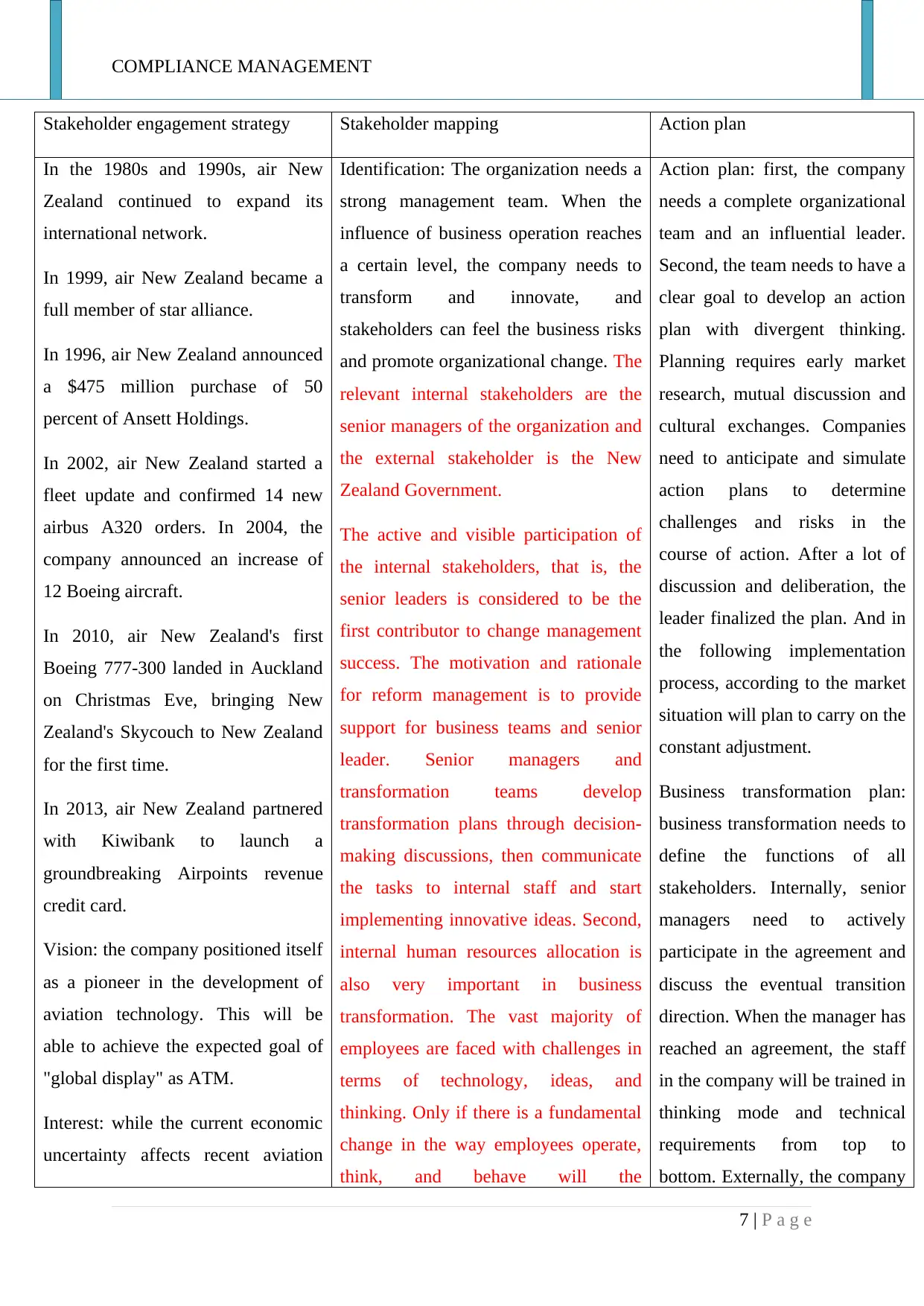
COMPLIANCE MANAGEMENT
Stakeholder engagement strategy Stakeholder mapping Action plan
In the 1980s and 1990s, air New
Zealand continued to expand its
international network.
In 1999, air New Zealand became a
full member of star alliance.
In 1996, air New Zealand announced
a $475 million purchase of 50
percent of Ansett Holdings.
In 2002, air New Zealand started a
fleet update and confirmed 14 new
airbus A320 orders. In 2004, the
company announced an increase of
12 Boeing aircraft.
In 2010, air New Zealand's first
Boeing 777-300 landed in Auckland
on Christmas Eve, bringing New
Zealand's Skycouch to New Zealand
for the first time.
In 2013, air New Zealand partnered
with Kiwibank to launch a
groundbreaking Airpoints revenue
credit card.
Vision: the company positioned itself
as a pioneer in the development of
aviation technology. This will be
able to achieve the expected goal of
"global display" as ATM.
Interest: while the current economic
uncertainty affects recent aviation
Identification: The organization needs a
strong management team. When the
influence of business operation reaches
a certain level, the company needs to
transform and innovate, and
stakeholders can feel the business risks
and promote organizational change. The
relevant internal stakeholders are the
senior managers of the organization and
the external stakeholder is the New
Zealand Government.
The active and visible participation of
the internal stakeholders, that is, the
senior leaders is considered to be the
first contributor to change management
success. The motivation and rationale
for reform management is to provide
support for business teams and senior
leader. Senior managers and
transformation teams develop
transformation plans through decision-
making discussions, then communicate
the tasks to internal staff and start
implementing innovative ideas. Second,
internal human resources allocation is
also very important in business
transformation. The vast majority of
employees are faced with challenges in
terms of technology, ideas, and
thinking. Only if there is a fundamental
change in the way employees operate,
think, and behave will the
Action plan: first, the company
needs a complete organizational
team and an influential leader.
Second, the team needs to have a
clear goal to develop an action
plan with divergent thinking.
Planning requires early market
research, mutual discussion and
cultural exchanges. Companies
need to anticipate and simulate
action plans to determine
challenges and risks in the
course of action. After a lot of
discussion and deliberation, the
leader finalized the plan. And in
the following implementation
process, according to the market
situation will plan to carry on the
constant adjustment.
Business transformation plan:
business transformation needs to
define the functions of all
stakeholders. Internally, senior
managers need to actively
participate in the agreement and
discuss the eventual transition
direction. When the manager has
reached an agreement, the staff
in the company will be trained in
thinking mode and technical
requirements from top to
bottom. Externally, the company
7 | P a g e
Stakeholder engagement strategy Stakeholder mapping Action plan
In the 1980s and 1990s, air New
Zealand continued to expand its
international network.
In 1999, air New Zealand became a
full member of star alliance.
In 1996, air New Zealand announced
a $475 million purchase of 50
percent of Ansett Holdings.
In 2002, air New Zealand started a
fleet update and confirmed 14 new
airbus A320 orders. In 2004, the
company announced an increase of
12 Boeing aircraft.
In 2010, air New Zealand's first
Boeing 777-300 landed in Auckland
on Christmas Eve, bringing New
Zealand's Skycouch to New Zealand
for the first time.
In 2013, air New Zealand partnered
with Kiwibank to launch a
groundbreaking Airpoints revenue
credit card.
Vision: the company positioned itself
as a pioneer in the development of
aviation technology. This will be
able to achieve the expected goal of
"global display" as ATM.
Interest: while the current economic
uncertainty affects recent aviation
Identification: The organization needs a
strong management team. When the
influence of business operation reaches
a certain level, the company needs to
transform and innovate, and
stakeholders can feel the business risks
and promote organizational change. The
relevant internal stakeholders are the
senior managers of the organization and
the external stakeholder is the New
Zealand Government.
The active and visible participation of
the internal stakeholders, that is, the
senior leaders is considered to be the
first contributor to change management
success. The motivation and rationale
for reform management is to provide
support for business teams and senior
leader. Senior managers and
transformation teams develop
transformation plans through decision-
making discussions, then communicate
the tasks to internal staff and start
implementing innovative ideas. Second,
internal human resources allocation is
also very important in business
transformation. The vast majority of
employees are faced with challenges in
terms of technology, ideas, and
thinking. Only if there is a fundamental
change in the way employees operate,
think, and behave will the
Action plan: first, the company
needs a complete organizational
team and an influential leader.
Second, the team needs to have a
clear goal to develop an action
plan with divergent thinking.
Planning requires early market
research, mutual discussion and
cultural exchanges. Companies
need to anticipate and simulate
action plans to determine
challenges and risks in the
course of action. After a lot of
discussion and deliberation, the
leader finalized the plan. And in
the following implementation
process, according to the market
situation will plan to carry on the
constant adjustment.
Business transformation plan:
business transformation needs to
define the functions of all
stakeholders. Internally, senior
managers need to actively
participate in the agreement and
discuss the eventual transition
direction. When the manager has
reached an agreement, the staff
in the company will be trained in
thinking mode and technical
requirements from top to
bottom. Externally, the company
7 | P a g e
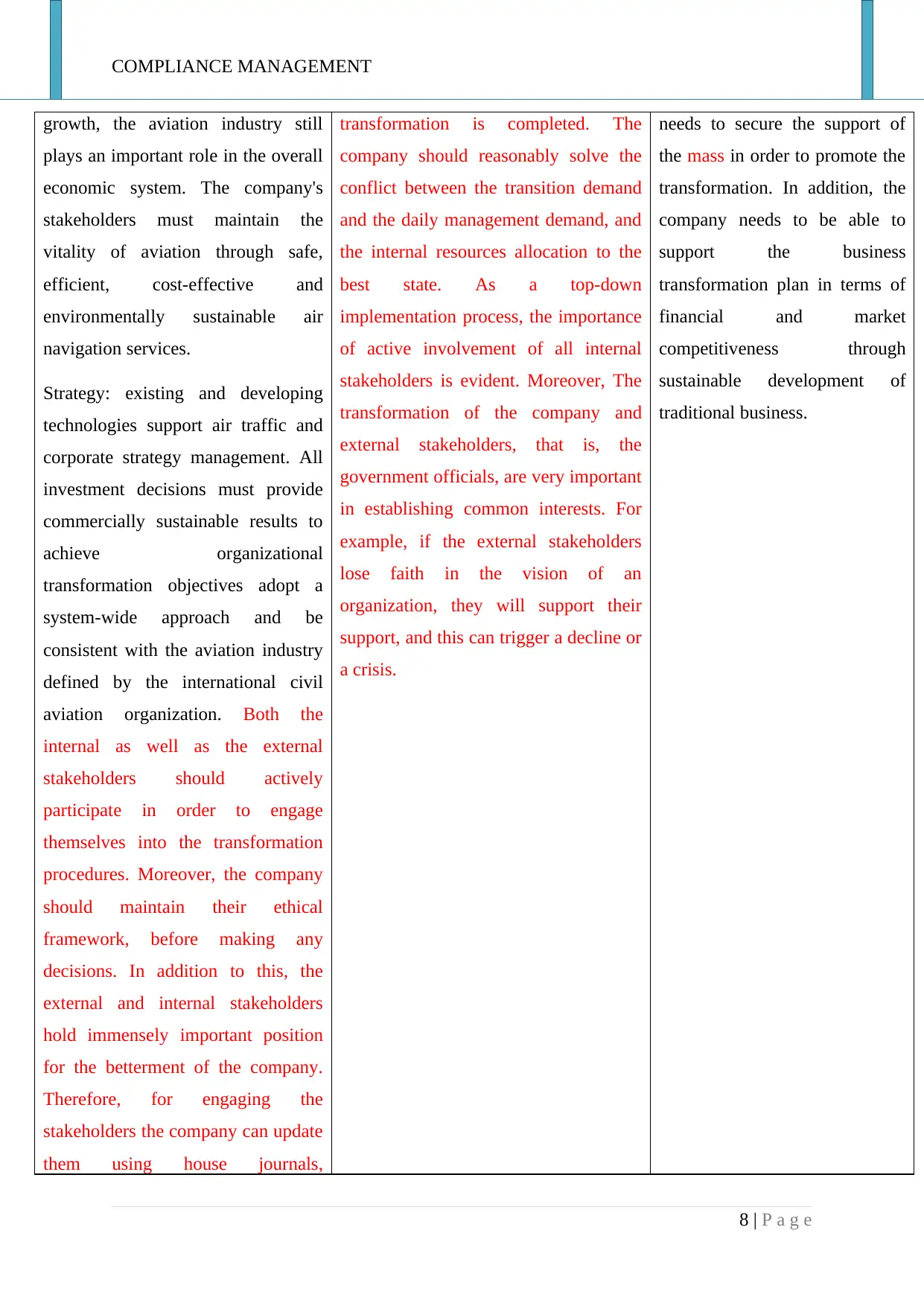
COMPLIANCE MANAGEMENT
growth, the aviation industry still
plays an important role in the overall
economic system. The company's
stakeholders must maintain the
vitality of aviation through safe,
efficient, cost-effective and
environmentally sustainable air
navigation services.
Strategy: existing and developing
technologies support air traffic and
corporate strategy management. All
investment decisions must provide
commercially sustainable results to
achieve organizational
transformation objectives adopt a
system-wide approach and be
consistent with the aviation industry
defined by the international civil
aviation organization. Both the
internal as well as the external
stakeholders should actively
participate in order to engage
themselves into the transformation
procedures. Moreover, the company
should maintain their ethical
framework, before making any
decisions. In addition to this, the
external and internal stakeholders
hold immensely important position
for the betterment of the company.
Therefore, for engaging the
stakeholders the company can update
them using house journals,
transformation is completed. The
company should reasonably solve the
conflict between the transition demand
and the daily management demand, and
the internal resources allocation to the
best state. As a top-down
implementation process, the importance
of active involvement of all internal
stakeholders is evident. Moreover, The
transformation of the company and
external stakeholders, that is, the
government officials, are very important
in establishing common interests. For
example, if the external stakeholders
lose faith in the vision of an
organization, they will support their
support, and this can trigger a decline or
a crisis.
needs to secure the support of
the mass in order to promote the
transformation. In addition, the
company needs to be able to
support the business
transformation plan in terms of
financial and market
competitiveness through
sustainable development of
traditional business.
8 | P a g e
growth, the aviation industry still
plays an important role in the overall
economic system. The company's
stakeholders must maintain the
vitality of aviation through safe,
efficient, cost-effective and
environmentally sustainable air
navigation services.
Strategy: existing and developing
technologies support air traffic and
corporate strategy management. All
investment decisions must provide
commercially sustainable results to
achieve organizational
transformation objectives adopt a
system-wide approach and be
consistent with the aviation industry
defined by the international civil
aviation organization. Both the
internal as well as the external
stakeholders should actively
participate in order to engage
themselves into the transformation
procedures. Moreover, the company
should maintain their ethical
framework, before making any
decisions. In addition to this, the
external and internal stakeholders
hold immensely important position
for the betterment of the company.
Therefore, for engaging the
stakeholders the company can update
them using house journals,
transformation is completed. The
company should reasonably solve the
conflict between the transition demand
and the daily management demand, and
the internal resources allocation to the
best state. As a top-down
implementation process, the importance
of active involvement of all internal
stakeholders is evident. Moreover, The
transformation of the company and
external stakeholders, that is, the
government officials, are very important
in establishing common interests. For
example, if the external stakeholders
lose faith in the vision of an
organization, they will support their
support, and this can trigger a decline or
a crisis.
needs to secure the support of
the mass in order to promote the
transformation. In addition, the
company needs to be able to
support the business
transformation plan in terms of
financial and market
competitiveness through
sustainable development of
traditional business.
8 | P a g e
⊘ This is a preview!⊘
Do you want full access?
Subscribe today to unlock all pages.

Trusted by 1+ million students worldwide
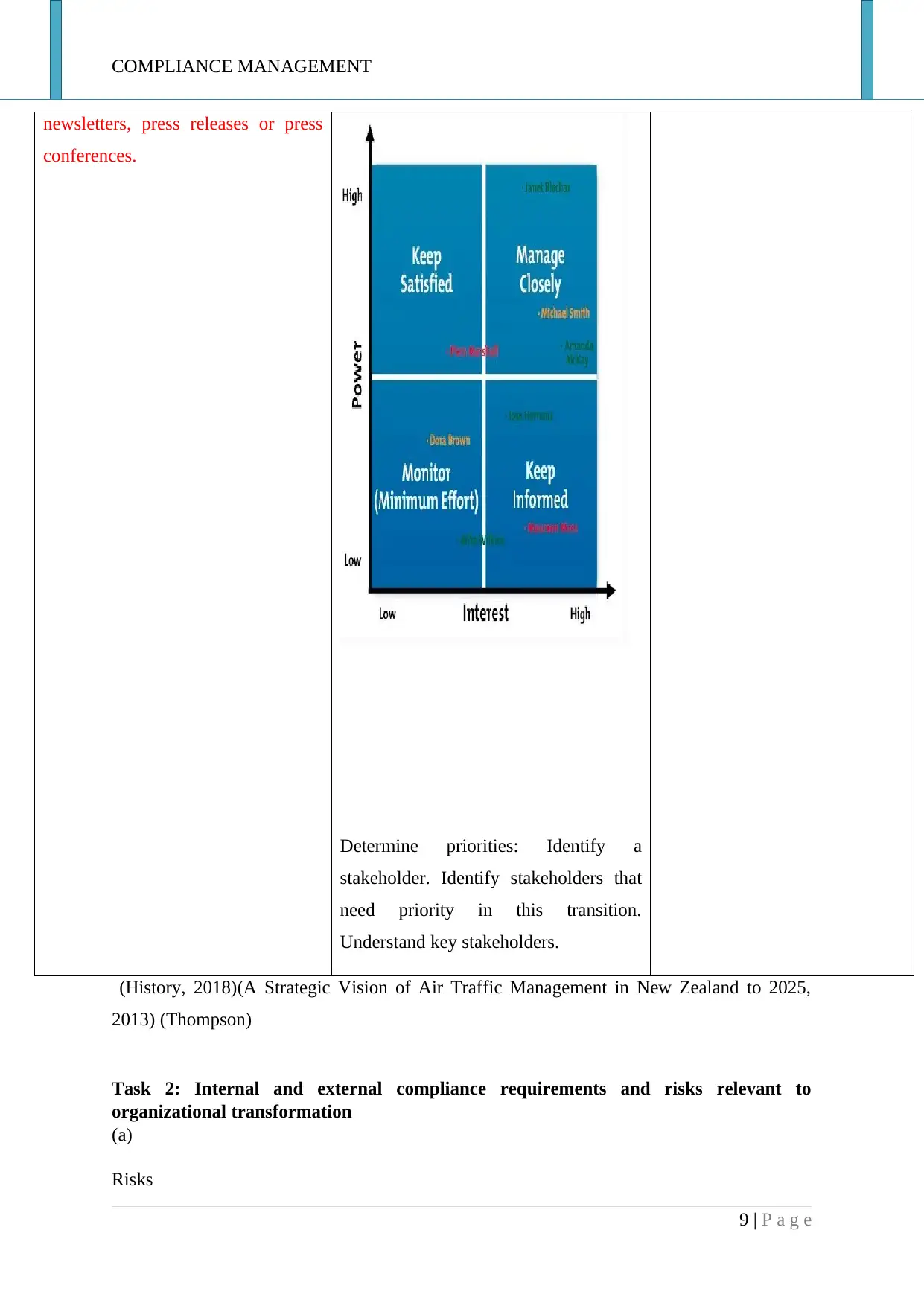
COMPLIANCE MANAGEMENT
newsletters, press releases or press
conferences.
Determine priorities: Identify a
stakeholder. Identify stakeholders that
need priority in this transition.
Understand key stakeholders.
(History, 2018)(A Strategic Vision of Air Traffic Management in New Zealand to 2025,
2013) (Thompson)
Task 2: Internal and external compliance requirements and risks relevant to
organizational transformation
(a)
Risks
9 | P a g e
newsletters, press releases or press
conferences.
Determine priorities: Identify a
stakeholder. Identify stakeholders that
need priority in this transition.
Understand key stakeholders.
(History, 2018)(A Strategic Vision of Air Traffic Management in New Zealand to 2025,
2013) (Thompson)
Task 2: Internal and external compliance requirements and risks relevant to
organizational transformation
(a)
Risks
9 | P a g e
Paraphrase This Document
Need a fresh take? Get an instant paraphrase of this document with our AI Paraphraser
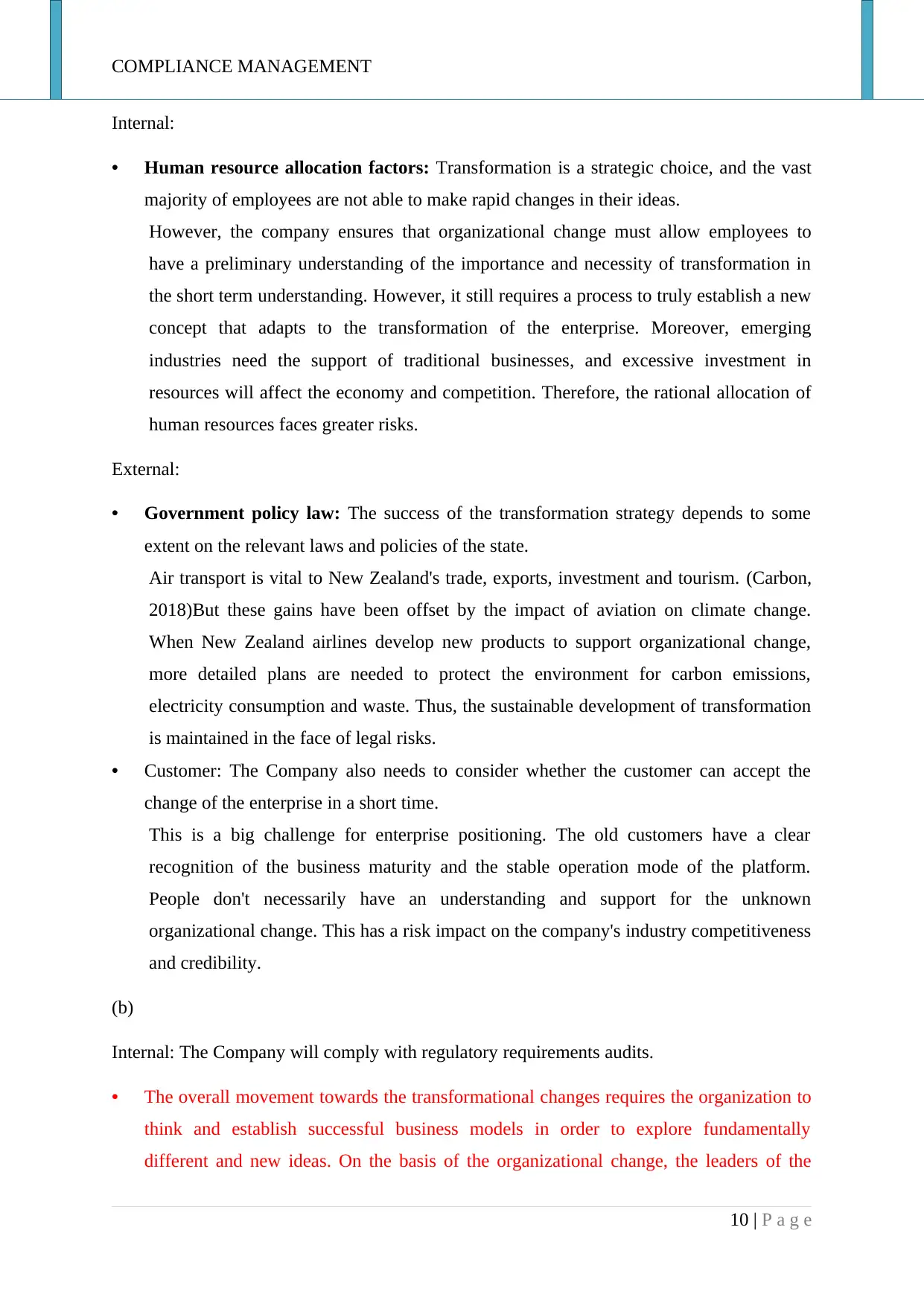
COMPLIANCE MANAGEMENT
Internal:
• Human resource allocation factors: Transformation is a strategic choice, and the vast
majority of employees are not able to make rapid changes in their ideas.
However, the company ensures that organizational change must allow employees to
have a preliminary understanding of the importance and necessity of transformation in
the short term understanding. However, it still requires a process to truly establish a new
concept that adapts to the transformation of the enterprise. Moreover, emerging
industries need the support of traditional businesses, and excessive investment in
resources will affect the economy and competition. Therefore, the rational allocation of
human resources faces greater risks.
External:
• Government policy law: The success of the transformation strategy depends to some
extent on the relevant laws and policies of the state.
Air transport is vital to New Zealand's trade, exports, investment and tourism. (Carbon,
2018)But these gains have been offset by the impact of aviation on climate change.
When New Zealand airlines develop new products to support organizational change,
more detailed plans are needed to protect the environment for carbon emissions,
electricity consumption and waste. Thus, the sustainable development of transformation
is maintained in the face of legal risks.
• Customer: The Company also needs to consider whether the customer can accept the
change of the enterprise in a short time.
This is a big challenge for enterprise positioning. The old customers have a clear
recognition of the business maturity and the stable operation mode of the platform.
People don't necessarily have an understanding and support for the unknown
organizational change. This has a risk impact on the company's industry competitiveness
and credibility.
(b)
Internal: The Company will comply with regulatory requirements audits.
• The overall movement towards the transformational changes requires the organization to
think and establish successful business models in order to explore fundamentally
different and new ideas. On the basis of the organizational change, the leaders of the
10 | P a g e
Internal:
• Human resource allocation factors: Transformation is a strategic choice, and the vast
majority of employees are not able to make rapid changes in their ideas.
However, the company ensures that organizational change must allow employees to
have a preliminary understanding of the importance and necessity of transformation in
the short term understanding. However, it still requires a process to truly establish a new
concept that adapts to the transformation of the enterprise. Moreover, emerging
industries need the support of traditional businesses, and excessive investment in
resources will affect the economy and competition. Therefore, the rational allocation of
human resources faces greater risks.
External:
• Government policy law: The success of the transformation strategy depends to some
extent on the relevant laws and policies of the state.
Air transport is vital to New Zealand's trade, exports, investment and tourism. (Carbon,
2018)But these gains have been offset by the impact of aviation on climate change.
When New Zealand airlines develop new products to support organizational change,
more detailed plans are needed to protect the environment for carbon emissions,
electricity consumption and waste. Thus, the sustainable development of transformation
is maintained in the face of legal risks.
• Customer: The Company also needs to consider whether the customer can accept the
change of the enterprise in a short time.
This is a big challenge for enterprise positioning. The old customers have a clear
recognition of the business maturity and the stable operation mode of the platform.
People don't necessarily have an understanding and support for the unknown
organizational change. This has a risk impact on the company's industry competitiveness
and credibility.
(b)
Internal: The Company will comply with regulatory requirements audits.
• The overall movement towards the transformational changes requires the organization to
think and establish successful business models in order to explore fundamentally
different and new ideas. On the basis of the organizational change, the leaders of the
10 | P a g e
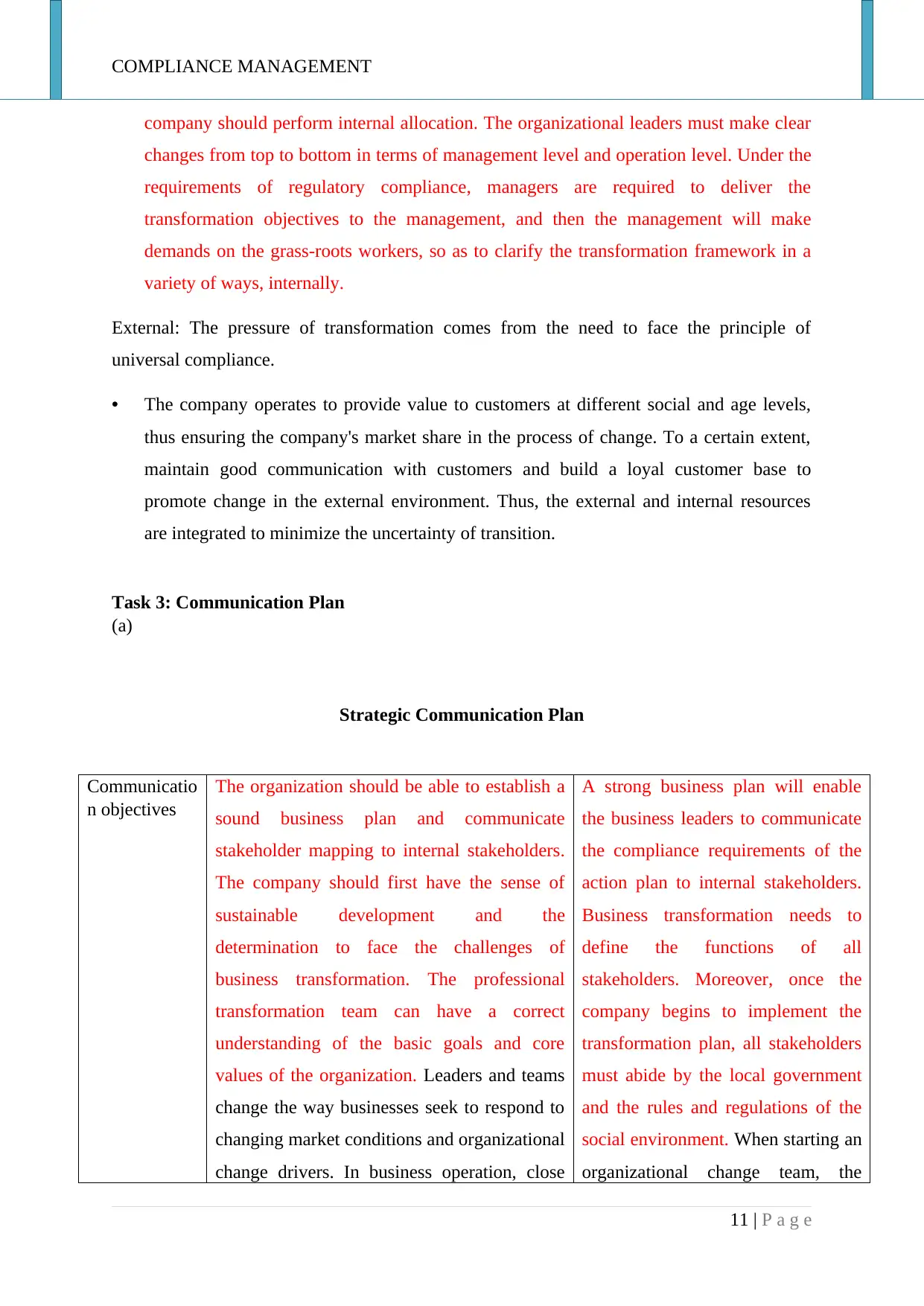
COMPLIANCE MANAGEMENT
company should perform internal allocation. The organizational leaders must make clear
changes from top to bottom in terms of management level and operation level. Under the
requirements of regulatory compliance, managers are required to deliver the
transformation objectives to the management, and then the management will make
demands on the grass-roots workers, so as to clarify the transformation framework in a
variety of ways, internally.
External: The pressure of transformation comes from the need to face the principle of
universal compliance.
• The company operates to provide value to customers at different social and age levels,
thus ensuring the company's market share in the process of change. To a certain extent,
maintain good communication with customers and build a loyal customer base to
promote change in the external environment. Thus, the external and internal resources
are integrated to minimize the uncertainty of transition.
Task 3: Communication Plan
(a)
Strategic Communication Plan
Communicatio
n objectives
The organization should be able to establish a
sound business plan and communicate
stakeholder mapping to internal stakeholders.
The company should first have the sense of
sustainable development and the
determination to face the challenges of
business transformation. The professional
transformation team can have a correct
understanding of the basic goals and core
values of the organization. Leaders and teams
change the way businesses seek to respond to
changing market conditions and organizational
change drivers. In business operation, close
A strong business plan will enable
the business leaders to communicate
the compliance requirements of the
action plan to internal stakeholders.
Business transformation needs to
define the functions of all
stakeholders. Moreover, once the
company begins to implement the
transformation plan, all stakeholders
must abide by the local government
and the rules and regulations of the
social environment. When starting an
organizational change team, the
11 | P a g e
company should perform internal allocation. The organizational leaders must make clear
changes from top to bottom in terms of management level and operation level. Under the
requirements of regulatory compliance, managers are required to deliver the
transformation objectives to the management, and then the management will make
demands on the grass-roots workers, so as to clarify the transformation framework in a
variety of ways, internally.
External: The pressure of transformation comes from the need to face the principle of
universal compliance.
• The company operates to provide value to customers at different social and age levels,
thus ensuring the company's market share in the process of change. To a certain extent,
maintain good communication with customers and build a loyal customer base to
promote change in the external environment. Thus, the external and internal resources
are integrated to minimize the uncertainty of transition.
Task 3: Communication Plan
(a)
Strategic Communication Plan
Communicatio
n objectives
The organization should be able to establish a
sound business plan and communicate
stakeholder mapping to internal stakeholders.
The company should first have the sense of
sustainable development and the
determination to face the challenges of
business transformation. The professional
transformation team can have a correct
understanding of the basic goals and core
values of the organization. Leaders and teams
change the way businesses seek to respond to
changing market conditions and organizational
change drivers. In business operation, close
A strong business plan will enable
the business leaders to communicate
the compliance requirements of the
action plan to internal stakeholders.
Business transformation needs to
define the functions of all
stakeholders. Moreover, once the
company begins to implement the
transformation plan, all stakeholders
must abide by the local government
and the rules and regulations of the
social environment. When starting an
organizational change team, the
11 | P a g e
⊘ This is a preview!⊘
Do you want full access?
Subscribe today to unlock all pages.

Trusted by 1+ million students worldwide
1 out of 16
Related Documents
Your All-in-One AI-Powered Toolkit for Academic Success.
+13062052269
info@desklib.com
Available 24*7 on WhatsApp / Email
![[object Object]](/_next/static/media/star-bottom.7253800d.svg)
Unlock your academic potential
Copyright © 2020–2025 A2Z Services. All Rights Reserved. Developed and managed by ZUCOL.





